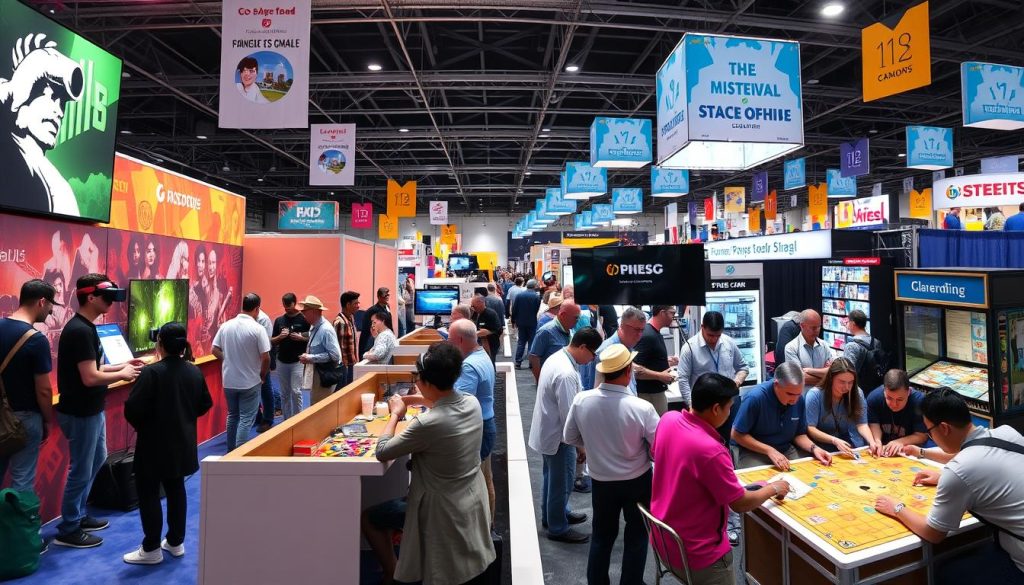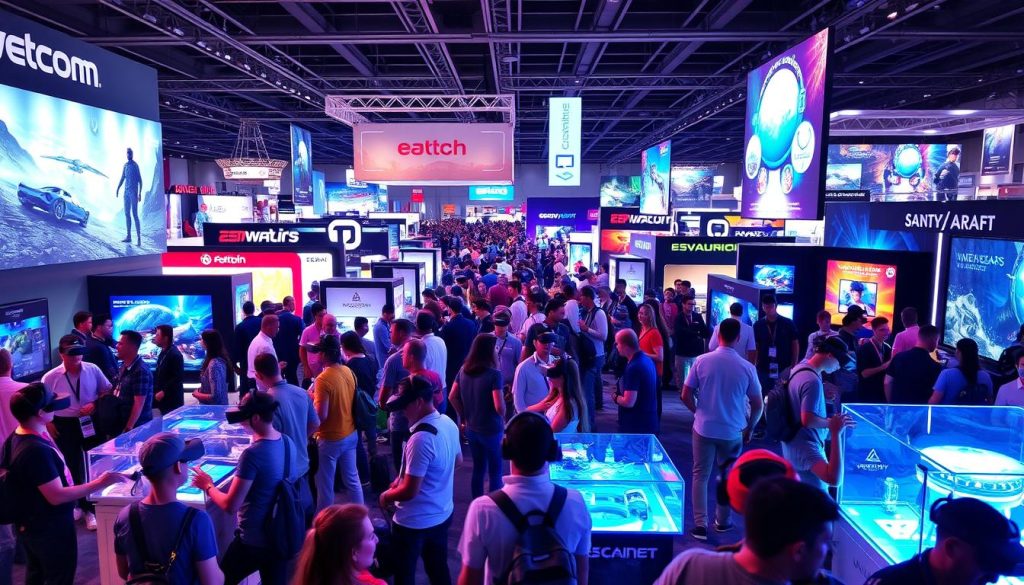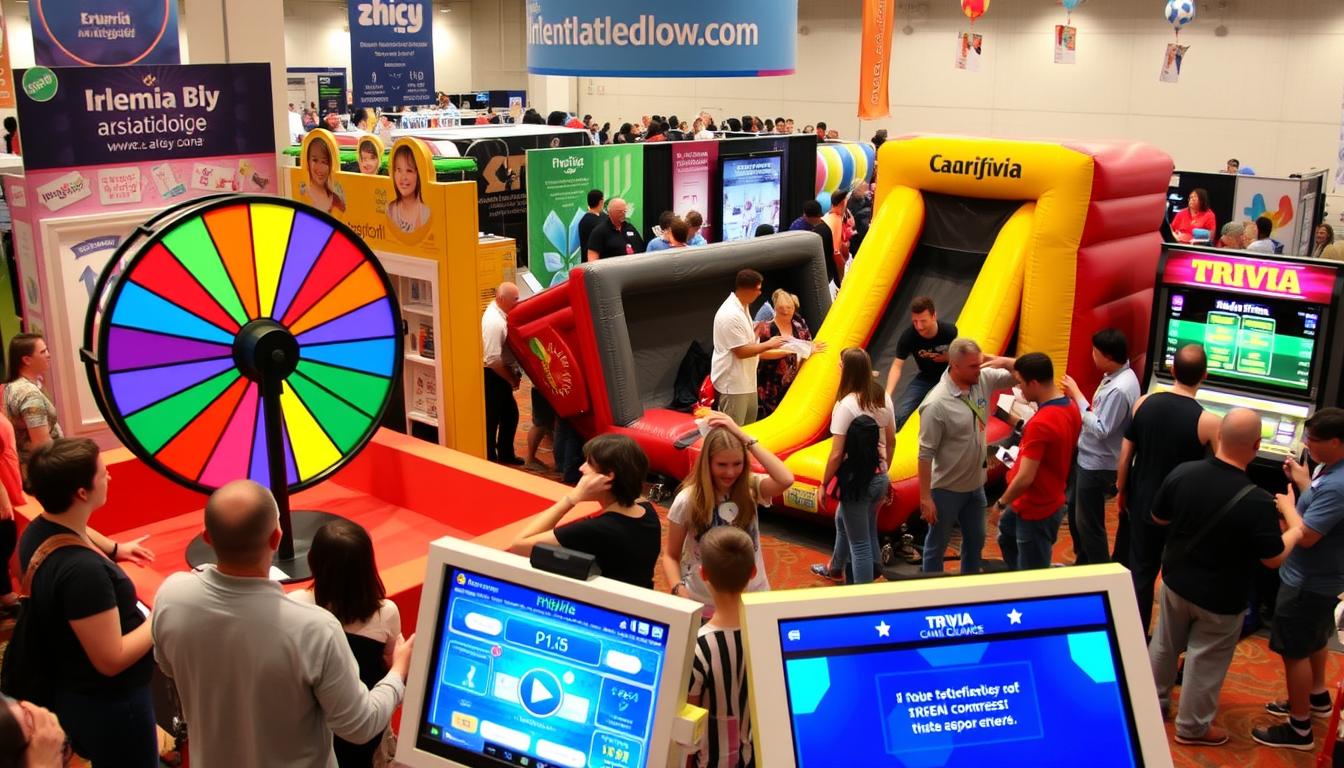Tradeshow booths can be a tough sell. With countless exhibitors vying for attention, how do you make your space stand out? The answer lies in interactive games. These engaging activities transform your booth into a hub of excitement, drawing visitors like moths to a flame.
By incorporating experiential marketing through games, you create memorable moments that stick with attendees long after the show ends. Interactive games not only boost visitor engagement but also provide a fun way to showcase your brand and products.
From digital quizzes to physical challenges, the right game can turn casual passersby into interested leads. It’s about creating an experience that’s both entertaining and informative, leaving a lasting impression that translates into business opportunities.
Key Takeaways
- Interactive games increase booth traffic and engagement
- Games provide a unique platform for brand activation
- Experiential marketing creates memorable brand experiences
- Well-designed games can improve lead generation
- Tradeshow games foster meaningful interactions with potential clients
Understanding the Power of Interactive Games at Trade Shows
Trade show marketing has evolved, and gamification is at the forefront of this change. Interactive games captivate audiences, boost visitor retention, and provide valuable engagement metrics. Let’s explore how these elements combine to create a powerful trade show strategy.
The Psychology Behind Gamification
Gamification taps into our innate desire for competition and reward. By incorporating game elements into trade show booths, exhibitors create an environment that naturally draws visitors. This approach leverages the brain’s reward system, releasing dopamine and creating positive associations with your brand.
How Games Drive Visitor Retention
Interactive games significantly increase booth dwell time. Visitors engaged in a game are more likely to stay, learn about your products, and remember your brand. This extended interaction provides ample opportunity to craft a compelling offer and showcase your unique value proposition.
Measuring Game-Based Engagement Success
Engagement metrics are crucial for assessing the effectiveness of your trade show games. Track participation rates, average play time, and lead generation numbers. These data points offer insights into visitor behavior and help refine your trade show marketing strategy for future events.
| Metric | Importance | Target |
|---|---|---|
| Participation Rate | Indicates attraction power | 50% of booth visitors |
| Average Play Time | Measures engagement level | 3-5 minutes |
| Lead Conversion | Shows ROI potential | 25% of players |
By understanding these key aspects of interactive games, you can create an irresistible trade show experience that drives results and leaves a lasting impression on attendees.
Top 5 Interactive Games to Make Your Tradeshow Booth Irresistible
Tradeshow success hinges on engaging visitors. Interactive booth games are the secret weapon for brand activation. Let’s explore five games that transform your space into an immersive experience.
1. Virtual Reality Challenge: Immerse attendees in a branded VR world. They’ll navigate obstacles, solve puzzles, or explore product features. This high-tech approach leaves a lasting impression.
2. Digital Scavenger Hunt: Create a mobile app-based quest around your booth. Participants scan QR codes, answer trivia, or find hidden objects. It’s a fun way to highlight key products or services.
3. Touchscreen Trivia: Set up large touchscreens with industry-related questions. Players compete for high scores, learning about your brand along the way. It’s educational and entertaining.
4. Augmented Reality Showcase: Use AR to bring your products to life. Visitors point their phones at displays to see 3D models, animations, or additional info. It’s a captivating way to showcase your offerings.
5. Social Media Photo Booth: Install a branded photo booth with props. Encourage visitors to share their pics online with your hashtag. It’s instant social proof and extends your reach beyond the show floor.
| Game | Engagement Level | Tech Requirement | Lead Generation Potential |
|---|---|---|---|
| VR Challenge | High | Advanced | Medium |
| Digital Scavenger Hunt | Medium | Moderate | High |
| Touchscreen Trivia | Medium | Moderate | High |
| AR Showcase | High | Advanced | Medium |
| Social Media Photo Booth | Medium | Low | High |
These interactive exhibits not only draw crowds but create memorable experiences tied to your brand. Choose the game that best fits your goals and watch your booth become the talk of the tradeshow.
Essential Elements of Successful Trade Show Games
Creating engaging games for trade shows takes careful planning. A well-designed game can boost your tradeshow strategy and leave a lasting impression on visitors. Let’s explore the key components that make trade show games irresistible.
Game Duration and Flow Management
The ideal game length keeps visitors engaged without holding up the line. Aim for quick rounds lasting 2-3 minutes. This allows for smooth flow and gives more people a chance to play. A fast-paced game design maintains excitement and prevents boredom.
Prize Structure and Incentives
Offering appealing prizes is crucial for attracting participants. Structure your rewards to include both instant wins and grand prizes. This mix of visitor incentives keeps players coming back. Consider branded items or exclusive discounts as giveaways. Effective lead generation often starts with enticing prizes.
Branding Integration Strategies
Seamlessly weave your brand into the game experience. Use your company colors, logo, and messaging throughout the game design. This brand integration reinforces your identity while players have fun. Create custom game elements that highlight your products or services. The goal is to make your brand memorable long after the trade show ends.
| Element | Best Practice |
|---|---|
| Game Duration | 2-3 minutes per round |
| Prize Types | Mix of instant wins and grand prizes |
| Branding | Integrate logo, colors, and messaging |
By focusing on these elements, you’ll create a game that not only entertains but also supports your overall tradeshow strategy. Remember, the key is to balance fun with effective marketing to make your booth truly irresistible.
Digital vs Traditional Game Options for Trade Shows

Trade show organizers face a crucial choice between digital games and traditional games when planning interactive exhibits. Both options offer unique advantages for engaging visitors and creating memorable experiences. Let’s explore the key differences to help you make an informed decision for your next event.
Digital games leverage technology integration to provide immersive experiences. These games often feature touchscreens, virtual reality, or augmented reality elements. They can collect data effortlessly and offer real-time analytics. Digital options are perfect for tech-savvy audiences and can easily incorporate branding elements.
Traditional games, on the other hand, rely on physical interactions and tangible components. These games often have a nostalgic appeal and can create a more personal connection with participants. They’re typically easier to set up and don’t require complex technology, making them a reliable choice for various venues.
When selecting between digital and traditional games, consider your target audience, budget, and overall marketing goals. Some trade show strategies may benefit from a mix of both types to cater to diverse preferences.
| Aspect | Digital Games | Traditional Games |
|---|---|---|
| Technology | High-tech, requires power | Low-tech, minimal setup |
| Engagement | Visual and interactive | Tactile and physical |
| Data Collection | Automated and comprehensive | Manual, often limited |
| Cost | Higher initial investment | Lower upfront costs |
| Customization | Highly customizable | Limited customization options |
Ultimately, the choice between digital and traditional games depends on your specific trade show goals and target audience preferences. By carefully considering these factors, you can create interactive exhibits that captivate attendees and leave a lasting impression.
Creating a Memorable Brand Experience Through Games
Games at trade shows offer a unique opportunity to craft unforgettable brand experiences. By blending storytelling, brand messages, and emotional connections, companies can leave a lasting impression on visitors. Let’s explore how to make your booth the talk of the show.
Storytelling Through Interactive Play
Interactive games provide a canvas for brand storytelling. By weaving your company’s narrative into gameplay, you create a brand experience that resonates. For instance, a sustainability-focused firm might design an eco-themed puzzle game, highlighting their green initiatives while engaging players.
Incorporating Brand Messages
Seamlessly integrating brand messages into games enhances recall. Use trivia questions about your products or services, or create virtual tours of your offerings. This approach turns passive observers into active participants, fostering deeper connections with your brand.
Building Emotional Connections
Emotional marketing through games can forge strong bonds with potential clients. Design challenges that evoke positive emotions like excitement or accomplishment. A well-crafted game can transform a brief interaction into a memorable experience, laying the groundwork for future business relationships.
| Game Element | Brand Impact | Emotional Response |
|---|---|---|
| Interactive Quiz | Educates about products | Curiosity, Confidence |
| Virtual Reality Tour | Showcases services | Wonder, Excitement |
| Team Challenge | Demonstrates values | Camaraderie, Achievement |
By combining storytelling, brand messaging, and emotional engagement, your trade show games can create a powerful experiential marketing platform. This approach not only attracts visitors but also transforms them into potential leads, making your booth a must-visit destination at any event.
Technology Integration in Trade Show Gaming
Trade show gaming has evolved with cutting-edge technology. AR/VR games now offer immersive experiences that captivate visitors. These games transport attendees to virtual worlds, showcasing products in innovative ways.

Touchscreen technology has revolutionized booth interactions. Interactive exhibits featuring large displays allow multiple users to engage simultaneously. Visitors can explore product catalogs, play games, or fill out surveys with a simple touch.
Mobile integration has become crucial for trade show success. Apps that sync with booth games extend the experience beyond the event floor. Attendees can continue playing, earning points, or learning about products long after they’ve left your booth.
“Interactive exhibits powered by technology create lasting impressions and drive engagement at trade shows.”
To maximize the impact of technology in trade show gaming, consider integrating social media platforms with your interactive experiences. This approach can boost engagement and extend your reach beyond the event.
| Technology | Benefits | Implementation Challenges |
|---|---|---|
| AR/VR Games | Immersive product demos, memorable experiences | High initial cost, space requirements |
| Touchscreen Displays | Multi-user interaction, easy information access | Software development, content creation |
| Mobile Integration | Extended engagement, data collection | App development, user adoption |
| Social Media Integration | Wider reach, real-time engagement | Platform compatibility, content moderation |
Lead Generation Strategies Using Interactive Games
Interactive games at trade shows offer a unique opportunity for lead generation. By engaging visitors in fun activities, companies can collect valuable data and nurture potential customers. Let’s explore effective strategies to turn game participants into qualified leads.
Data Collection Best Practices
Collecting data is crucial for successful lead generation. Use game mechanics to gather essential information. Ask players to provide their contact details before starting the game. Keep forms short and simple to encourage participation. Consider offering a small incentive for data sharing.
Follow-up Techniques
Effective follow-up is key to converting leads. Segment your contacts based on game performance or interests. Personalize your outreach using the data collected. Send a thank-you email with relevant content or offers. Consider using social media to engage with leads post-event.
Converting Players into Prospects
Turn casual players into serious prospects with targeted conversion tactics. Create a scoring system to identify high-potential leads. Develop a nurturing campaign tailored to each segment. Provide value through educational content or exclusive offers. Use retargeting to keep your brand top-of-mind.
| Strategy | Implementation | Expected Outcome |
|---|---|---|
| Gamified Data Collection | Integrate data capture into game mechanics | Increased lead quality and quantity |
| Personalized Follow-up | Tailor communication based on game performance | Higher engagement rates |
| Lead Scoring | Assign points based on game interaction and data provided | Improved sales team efficiency |
| Content Marketing | Share relevant content post-event | Increased brand authority and trust |
By implementing these strategies, you can maximize the potential of your interactive games for lead generation. Remember to analyze your results and refine your approach for future events.
Measuring ROI from Trade Show Games
Tracking the success of your trade show games is key to understanding their value. ROI measurement helps you see if your interactive activities are worth the investment. By looking at engagement metrics, you can gauge how well your games captured attendees’ attention.
Lead quality is a crucial factor in determining tradeshow success. Games can attract many visitors, but it’s important to assess if these leads are likely to become customers. Keep track of how many game participants follow up after the event or make purchases.
To measure ROI effectively, set clear goals before the event. Count the number of people who played your games and compare it to overall booth traffic. Use surveys to gather feedback on the gaming experience. These insights will help you refine your strategy for future trade shows, ensuring your games continue to drive meaningful interactions and business growth.
FAQ
How do interactive games enhance visitor engagement at trade shows?
Interactive games at trade shows boost visitor engagement by creating fun, memorable experiences. They encourage longer booth dwell times, facilitate brand interactions, and provide a unique way to communicate your message. Games also tap into people’s competitive nature, making your booth more attractive and increasing the likelihood of meaningful conversations with potential leads.
What types of games work best for trade show booths?
The most effective games for trade show booths are those that are quick to play, easy to understand, and align with your brand message. Popular options include touchscreen quizzes, virtual reality experiences, prize wheels, interactive product demos, and social media-integrated photo booths. The best game choice depends on your target audience, booth size, and overall marketing objectives.
How can I measure the success of my trade show game?
To measure the success of your trade show game, track metrics such as booth traffic, participant numbers, lead generation, and post-show follow-ups. You can also measure dwell time, social media mentions, and brand recall through post-event surveys. Compare these metrics to your previous trade show performances or industry benchmarks to gauge improvement.
Are digital games better than traditional games for trade shows?
Both digital and traditional games have their merits for trade shows. Digital games often offer more data collection opportunities, easier customization, and a “wow” factor with cutting-edge technology. Traditional games, on the other hand, can provide a tactile experience and may be more accessible to all attendees. The best choice depends on your target audience, budget, and specific goals for the event.
How can I integrate my brand message into a trade show game?
Integrate your brand message into a trade show game by incorporating your logo, using brand colors, and featuring product information within the game design. Create game scenarios or questions that highlight your company’s unique selling points. Consider developing a game that demonstrates your product’s benefits or simulates problem-solving using your services. The key is to make the brand integration feel natural and enhance the overall game experience.
What are some effective prize strategies for trade show games?
Effective prize strategies for trade show games include offering a mix of immediate small prizes (like branded merchandise) and the chance to win larger grand prizes. Consider tiered prizes based on performance or participation levels. Ensure prizes are desirable to your target audience and relevant to your industry. Sometimes, exclusive access to content, special discounts, or VIP experiences can be more valuable than physical items.


